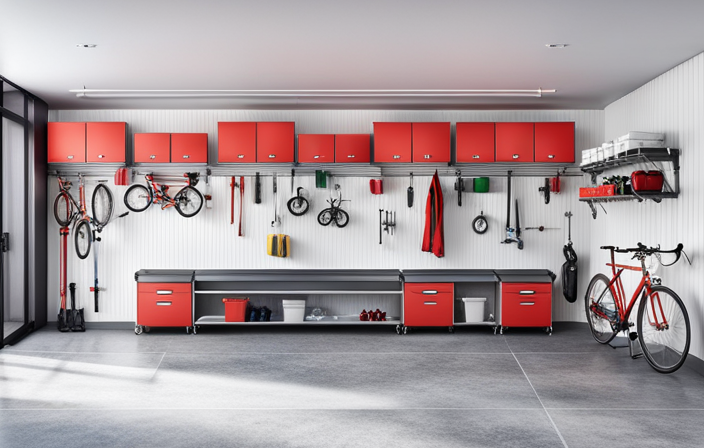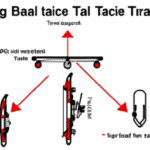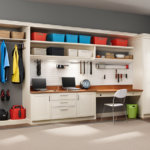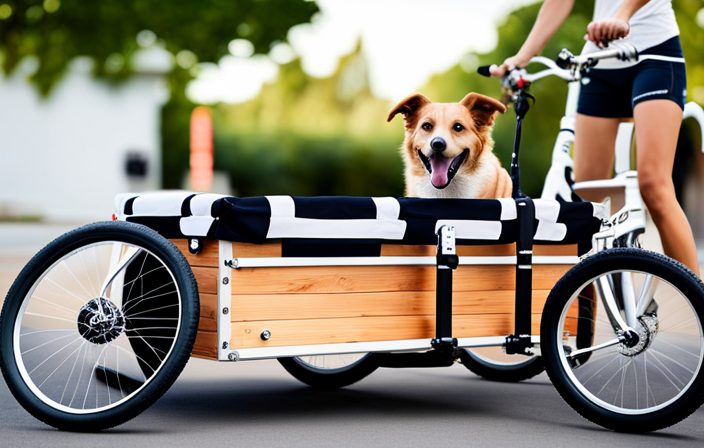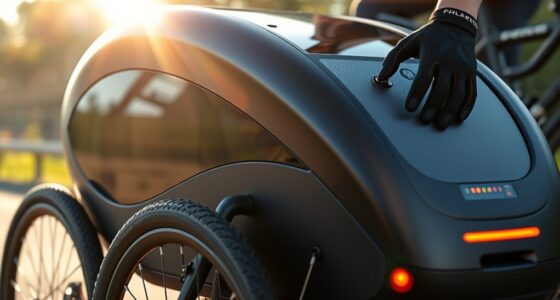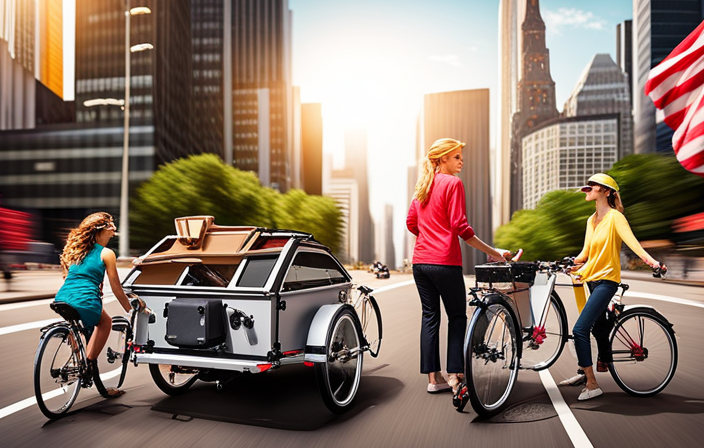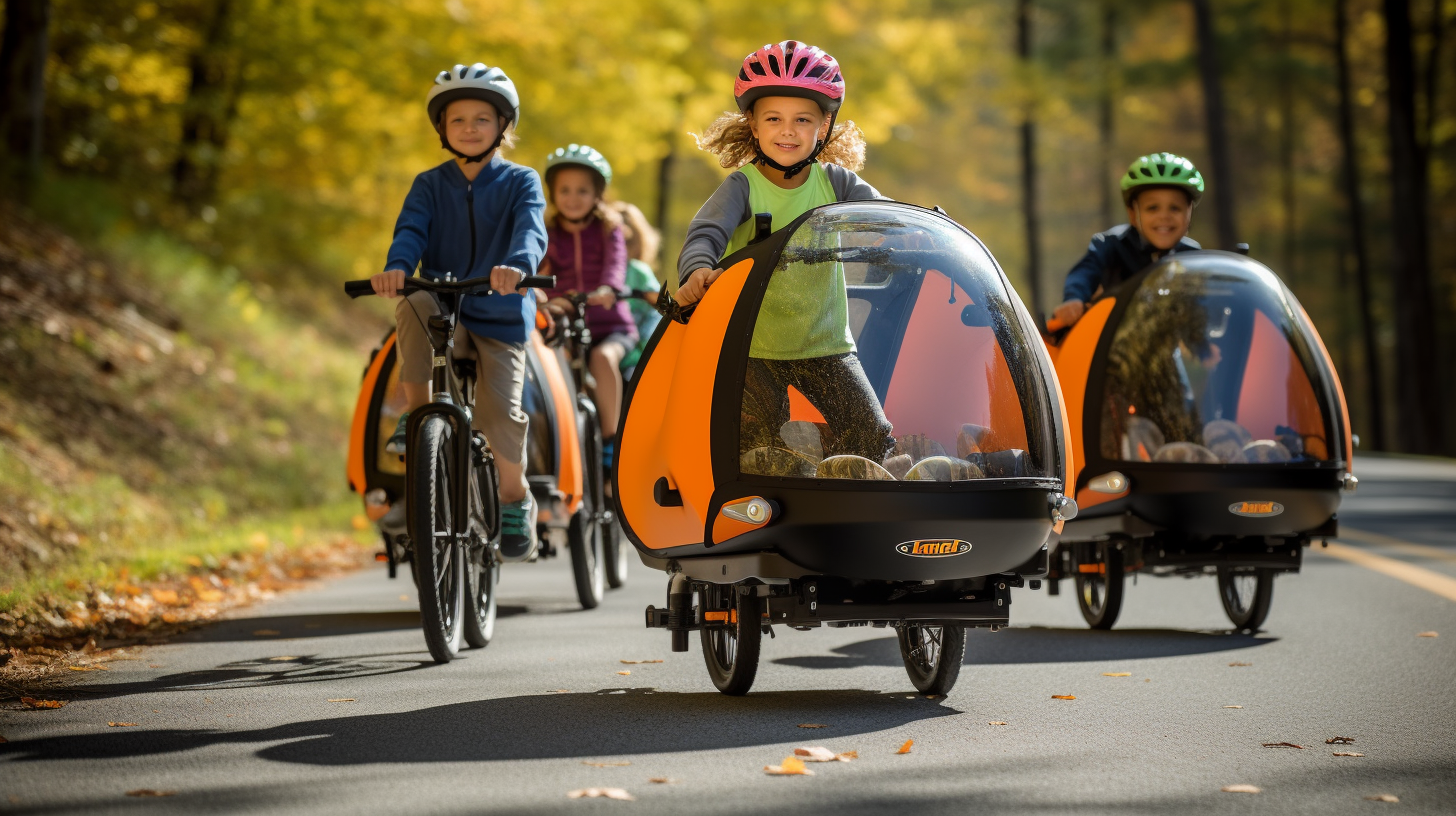As I make my way through the chaotic depths of my garage, I have come to the realization that storing my bike trailers has become quite a challenging endeavor. However, do not worry, dear reader! I am on a mission to discover the secrets of effective bike trailer storage.
In this informative and practical article, I will guide you through the steps to assess your available space, choose the right storage solution, and properly care for your bike trailer.
So, let’s embark on this journey together and reclaim our garage from the clutches of chaos!
Key Takeaways
- Measure the dimensions of the garage and evaluate existing storage systems to maximize available space and consider the layout.
- Group similar items together for organization and get rid of unused or unnecessary items to clear out clutter.
- Choose the right storage solution such as wall-mounted hooks or brackets, ceiling hoists, or bike trailer storage racks for easy access and to free up space in the garage.
- Properly store and protect the bike trailer by investing in a durable cover, using foam padding or blankets for cushioning, elevating it off the ground, and storing it in a dry and clean area to prevent damage and rust.
Assess the Available Space in Your Garage
Before you start storing bike trailers in your garage, you should assess the available space. It’s important to have a clear understanding of how much room you have to work with in order to effectively organize your garage storage.
Start by measuring the dimensions of your garage, including the height, width, and depth. This will give you a good idea of how much space you have to work with and what size bike trailers will fit comfortably.
Next, take a look at the current state of your garage. Are there any existing storage systems or shelves that can be utilized? Are there any obstacles or obstructions that may limit the available space? Consider the layout of your garage and how you can maximize the use of the available area.
Once you have assessed the available space, it’s time to start organizing your garage storage. Begin by grouping similar items together, such as bike accessories, tools, and outdoor gear. This will make it easier to find what you need when you’re ready to use your bike trailer. Use storage bins, shelves, or hooks to keep everything organized and off the floor.
Clear out any Clutter or Unnecessary Items
While you’re clearing out any clutter or unnecessary items in the garage, make sure to create space for the bike trailers. Assessing the available storage options is crucial to ensure that your bike trailers are properly secured and easily accessible when needed.
Start by organizing the garage and getting rid of any items that you no longer use or need. This will not only create more space but also make it easier to find a suitable storage solution for the bike trailers.
Once you have cleared out the clutter, it’s time to properly secure the bike trailer. This can be done by using hooks or wall-mounted racks specifically designed for bike storage. These options allow you to hang the bike trailer vertically, saving valuable floor space in the garage. Make sure that the hooks or racks are securely installed and can support the weight of the bike trailer.
In addition to hooks and racks, consider using storage bins or shelves to keep any bike trailer accessories organized and easily accessible. This will help to maximize the available space and keep everything in one place.
Choose the Right Storage Solution for Your Bike Trailer
Once you’ve cleared out the clutter and properly secured the bike trailer, it’s time to choose the right storage solution for it. Proper storage is essential to keep your bike trailer in good condition and ready for your next adventure.
Here are some storage options and maintenance tips to help you make the best choice:
-
Wall mount: Consider installing wall-mounted hooks or brackets to hang your bike trailer. This option keeps it off the floor and out of the way, maximizing your garage space.
-
Ceiling hoist: If you have limited floor space, a ceiling hoist is a great option. It allows you to lift and suspend the bike trailer from the ceiling, creating more room for other items.
-
Storage rack: A bike trailer storage rack is a practical solution for those who want easy access. These racks typically feature adjustable arms or hooks to hold the trailer securely in place.
Proper maintenance is also crucial for the longevity of your bike trailer. Regularly clean and lubricate the wheels, check the tires for wear and tear, and inspect the frame for any damage. By considering the weight and size of your bike trailer, you can ensure that the storage solution you choose will adequately support and protect it.
Consider the Weight and Size of Your Bike Trailer
When choosing a storage solution for your bike trailer, make sure to consider its weight and size to ensure proper support and protection. Assessing trailer compatibility is essential to prevent any damage or instability when storing it in your garage. You need to ensure that the storage solution you choose can handle the weight of your bike trailer without collapsing or causing any harm. Additionally, you should take into account the size of your trailer to make sure it fits properly and doesn’t take up too much space in your garage.
Ensuring proper storage conditions is crucial to maintain the longevity of your bike trailer. You should store it in a dry and clean area to prevent rust and deterioration. Moisture can cause damage to the metal parts of your trailer, so it’s essential to keep it in a climate-controlled environment if possible. Furthermore, you should avoid storing your trailer near any chemicals or sharp objects that could potentially harm it.
Use Proper Padding or Protection for Your Bike Trailer
Using adequate padding or protection for your bike trailer ensures that it remains free from scratches or dents. Proper maintenance is essential to prolong the lifespan of your bike trailer and protect it from the weather.
When storing your bike trailer in the garage, it’s important to provide a safe and secure environment. Start by investing in a durable cover specifically designed for bike trailers. This will shield your trailer from dust, moisture, and other potential damage. Additionally, consider using foam padding or blankets to provide extra cushioning and protection against any accidental bumps or knocks.
It’s also a good idea to keep your bike trailer elevated off the ground to prevent any water damage. This can be done by using storage racks or hooks installed on the garage wall.
By taking these simple steps, you can ensure that your bike trailer remains in excellent condition and ready for your next adventure.
Now let’s move on to the next section and discuss how to securely attach your bike trailer to the storage solution.
Securely Attach Your Bike Trailer to the Storage Solution
To keep your bike trailer secure, make sure to attach it tightly to the storage solution. Whether you have a wall-mounted bike rack or a ceiling hoist, properly attaching your bike trailer will ensure that it stays in place and doesn’t fall or get damaged.
Start by finding a sturdy anchor point on your storage solution, such as a hook or a railing. Then, use strong straps or bungee cords to fasten the trailer securely. Make sure the straps are tightened properly to prevent any movement or shifting. This will not only keep your bike trailer safe but also free up space in your garage.
By securely attaching your bike trailer to the storage solution, you can be confident that it will be safe and protected. It will also be easily accessible for future use. When you need to take your bike trailer out again for your next adventure, you won’t have to spend time searching for it or untangling it from other items.
Keeping it securely attached to the storage solution will save you time and effort in the long run. So, take a few extra minutes to properly attach your bike trailer, and you’ll enjoy the convenience of having it easily accessible whenever you need it.
Keep Your Bike Trailer Easily Accessible for Future Use
By keeping your bike trailer securely attached to the storage solution, you’ll have easy access to it whenever you need it in the future. Proper maintenance for bike trailers is crucial to ensure their longevity and functionality. Here are some tips for organizing your garage storage space and keeping your bike trailer in top shape:
-
Clean and inspect: Before storing your bike trailer, give it a thorough cleaning to remove any dirt or debris. Inspect it for any damage or wear and tear that may need to be addressed before storage.
-
Remove detachable parts: If your bike trailer has any detachable parts, such as wheels or seats, remove them and store them separately. This will help save space and prevent any damage during storage.
-
Use hooks or racks: Install hooks or racks on the wall or ceiling of your garage to hang your bike trailer. This will keep it off the floor and free up valuable space. Make sure the hooks or racks are sturdy enough to support the weight of the trailer.
-
Label and organize: To easily locate your bike trailer when needed, label it with a tag or sticker. Additionally, organize your garage storage space so that the trailer is easily accessible without having to move other items.
Consider Installing Locks or Security Measures
When it comes to protecting your valuable equipment, you should consider installing locks or security measures for added peace of mind. Bike trailers are no exception. These trailers can be expensive and hold sentimental value, so it’s important to take precautions to keep them safe in your garage.
One option is to install bike racks specifically designed for trailers. These racks provide a secure place to store your trailer, keeping it off the ground and out of the way.
Another option is to utilize garage door sensors. These sensors can be connected to your garage door opener and will alert you if the door is opened or tampered with, providing an extra layer of security.
By incorporating these security measures, you can rest easy knowing that your bike trailer is protected from theft or damage.
Now, let’s explore another way to maximize the space in your garage and store your bike trailer efficiently: utilizing vertical space.
Utilize Vertical Space in Your Garage
If you’re looking to make the most of your garage space, one option is to take advantage of the vertical area available. Vertical storage solutions can help you maximize your garage space and keep it organized.
There are several ways you can utilize vertical space in your garage. One option is to install shelves or racks on the walls. These can be used to store items like tools, sports equipment, or gardening supplies. By using wall space for storage, you free up valuable floor space and make it easier to navigate around your garage.
Another vertical storage solution is to hang items from the ceiling. This can be done using hooks or pulley systems. Hanging items like bikes or ladders from the ceiling not only keeps them out of the way, but it also prevents them from taking up valuable floor or wall space.
By utilizing vertical space in your garage, you can maximize your storage options and make the most of the available area. However, if you need even more storage, you can also make use of wall space for additional storage. This can be done by installing cabinets or pegboards on the walls, which provide even more storage options for smaller items.
With these vertical storage solutions, you can make the most of your garage space and keep it organized and clutter-free.
Make Use of Wall Space for Additional Storage
To maximize your storage options, consider installing cabinets or pegboards on the walls. This will allow you to make use of the vertical space in your garage and create more room for storing your bike trailer.
Cabinets are a great option for storing smaller items such as bike accessories or maintenance tools. You can install them at various heights to accommodate different sizes of items.
Pegboards, on the other hand, provide a versatile storage solution. You can hang hooks and holders on the pegboard to hang your bike helmet, gloves, or even your bike pump. It’s a creative and efficient way to keep everything organized and easily accessible.
When installing cabinets or pegboards, it’s important to plan the layout carefully. Consider the height of your bike trailer when determining the placement of the cabinets or pegboards. You want to ensure that there is enough clearance for your trailer to fit comfortably underneath.
Additionally, make sure to secure the cabinets or pegboards properly to the wall to ensure they can support the weight of your items.
Create a Designated Area for Your Bike Trailer
When it comes to organizing bike trailer storage, one of the most important steps is to create a designated area for your trailer. This will not only help keep your garage tidy, but also make it easier to access your trailer whenever you need it.
To create a designated area, you can utilize different storage solutions that cater specifically to bike trailers. Here are some bike trailer storage ideas that can help you stay organized:
| Storage Solution | Description | Benefits |
|---|---|---|
| Wall-mounted hooks | Hang the bike trailer on the wall using sturdy hooks | Saves floor space, easy access |
| Ceiling-mounted pulley system | Use a pulley system to hoist the bike trailer up to the ceiling | Maximizes overhead space, keeps the trailer out of the way |
| Freestanding storage rack | Invest in a storage rack designed specifically for bike trailers | Provides a dedicated spot for the trailer, easy to move if needed |
Label and Organize Your Storage Space
Once you have designated areas for your belongings, it’s important to label and organize them to easily locate what you need. Maximizing storage efficiency is crucial, especially when it comes to storing bike trailers in the garage.
One effective way to achieve this is by utilizing overhead space. Installing sturdy hooks or racks on the ceiling allows you to hang your bike trailer, freeing up valuable floor space. This not only maximizes the storage capacity of your garage but also keeps your bike trailer safely out of the way.
To further enhance the organization of your storage space, labeling is key. Use clear and descriptive labels on bins or shelves to categorize your belongings. For example, you can have separate sections for bike accessories, spare parts, and maintenance tools. This will make it easier to find what you need quickly, saving you time and effort.
Regularly inspect and maintain your bike trailer to ensure it stays in good condition. Regular cleaning, lubricating the moving parts, and checking for any signs of wear and tear are essential steps in prolonging the lifespan of your trailer. By implementing these maintenance practices, you can enjoy your bike trailer for years to come.
Transitioning into the next section about regularly inspecting and maintaining your bike trailer, it’s important to prioritize the longevity and performance of your equipment.
Regularly Inspect and Maintain Your Bike Trailer
Regularly checking and maintaining your bike trailer ensures its longevity and optimal performance. By inspecting maintenance and identifying damages, you can address any issues before they become bigger problems.
Start by examining the frame for any signs of damage, such as cracks or dents. Check the wheels to make sure they are properly aligned and spin freely. Inspect the tires for wear and tear, and replace them if necessary. Don’t forget to check the brakes and ensure they are functioning properly.
Lubricate the moving parts, such as hinges and couplers, to prevent rust and ensure smooth operation. Additionally, inspect the fabric or material of the trailer for any tears or holes, as these can compromise its safety and functionality.
By regularly inspecting and maintaining your bike trailer, you can extend its lifespan and ensure a safe and enjoyable ride for you and your little ones.
In addition to regular maintenance, it is important to consider climate control and temperature regulation when storing your bike trailer. Extreme temperatures can have a negative impact on the materials and components of the trailer. Excessive heat can cause the fabric to fade or even melt, while extreme cold can make it brittle and prone to cracking.
To protect your bike trailer, store it in a temperature-controlled environment, such as a garage or basement. If that’s not possible, consider using a cover or tarp to shield it from direct sunlight and extreme weather conditions.
Taking these steps will help to ensure that your bike trailer remains in top condition and ready for your next adventure.
Consider Climate Control and Temperature Regulation
It’s important to protect your bike trailer from extreme temperatures to prevent damage to its materials and components. Proper climate control and temperature regulation techniques can help ensure the longevity and functionality of your trailer.
Here are a few benefits of climate control and some techniques to consider:
-
Climate Control Benefits:
-
Prevents excessive heat or cold from warping or weakening the trailer’s frame and components.
-
Maintains the integrity of the trailer’s tires, preventing cracking or deterioration.
-
Temperature Regulation Techniques:
-
Insulate your garage to help maintain a consistent temperature. This can be done by adding insulation to the walls and ceiling or using weatherstripping on the garage door.
-
Use a dehumidifier or moisture absorbers to prevent moisture buildup inside the trailer, which can lead to rust or mold.
By implementing climate control techniques and regulating the temperature in your garage, you can protect your bike trailer from extreme conditions and extend its lifespan.
Seek Professional Advice or Assistance if Needed
If you need assistance or have any questions about the best ways to protect your bike trailer from extreme conditions, don’t hesitate to seek professional advice. Proper assistance can make a significant difference in maintaining the longevity and functionality of your bike trailer.
When it comes to storing your trailer in the garage, it’s essential to consider various factors, such as climate control and temperature regulation. However, if you’re unsure about the specific requirements for your trailer, seeking professional advice can provide you with the necessary guidance.
Professional advice can help you determine the best storage practices for your bike trailer based on its make, model, and materials. Experts can offer insights on the ideal temperature and humidity levels to maintain, the most suitable storage location within your garage, and any additional precautions you should take. They can also provide recommendations on protective covers or storage solutions that can further safeguard your trailer from extreme conditions.
By seeking professional advice, you can ensure that you’re taking the necessary steps to protect your bike trailer and prolong its lifespan. Don’t hesitate to reach out to experts who have the knowledge and experience in bike trailer storage. Their expertise can save you time, money, and potential damage in the long run.
Frequently Asked Questions
How do I properly secure my bike trailer to the storage solution?
To properly secure my bike trailer and prevent theft, there are a few key steps I follow.
First, I ensure that the trailer is securely attached to my bike using a reliable lock or hitch mechanism.
Then, I make sure to park my bike in a well-lit and visible area within the garage.
Additionally, I use a heavy-duty chain or lock to secure the trailer to a sturdy anchor point, such as a wall or post, providing an extra layer of security.
Are there any recommended locks or security measures for storing a bike trailer in the garage?
When it comes to securing a bike trailer in the garage, it’s important to treat it like a valuable treasure.
To ensure the safety of your bike trailer, there are a few recommended security measures you can take.
Firstly, invest in a sturdy lock specifically designed for bike trailer storage solutions.
Additionally, consider installing motion sensor lights or a security camera to deter potential thieves.
How can I utilize vertical space in my garage for bike trailer storage?
To maximize vertical space and organize your garage, there are several vertical storage solutions you can utilize.
Install overhead storage racks or shelves to store your bike trailer and other items off the ground.
Utilize wall-mounted hooks or hangers to hang the trailer vertically.
You can also consider using a pulley system to hoist the trailer up to the ceiling when not in use.
These solutions will help keep your garage organized and create more space for other belongings.
Are there any specific maintenance tasks I need to perform regularly on my bike trailer while it is in storage?
Maintenance tasks for bike trailers while in storage are essential to ensure their longevity and optimal performance. Proper storage techniques alone may not be sufficient.
Regularly lubricating the trailer’s moving parts, such as the wheels and axles, prevents rust and keeps them functioning smoothly.
Additionally, inspecting the trailer for any damage or wear and tear is crucial. For example, I once neglected to check the tire pressure on my bike trailer, resulting in a flat tire when I finally decided to use it.
What types of climate control or temperature regulation should I consider for storing my bike trailer in the garage?
When considering climate control options for storing my bike trailer in the garage, insulation requirements are crucial.
Insulating the garage will help regulate temperature and protect the trailer from extreme heat or cold. I can install insulation in the walls, ceiling, and garage door to create a more controlled environment.
Additionally, using a dehumidifier can prevent moisture damage.
These measures will ensure that my bike trailer remains in good condition throughout its storage period.
Conclusion
Well, there you have it! Storing bike trailers in the garage can be a daunting task, but with these simple tips, you’ll become a storage master in no time.
Clear out that clutter, choose the perfect storage solution, and don’t forget to properly protect and maintain your bike trailer.
And hey, if you really want to take it to the next level, consider climate control and seek professional advice.
Your bike trailer will be so cozy, you’ll want to snuggle up with it!
Happy storing!
